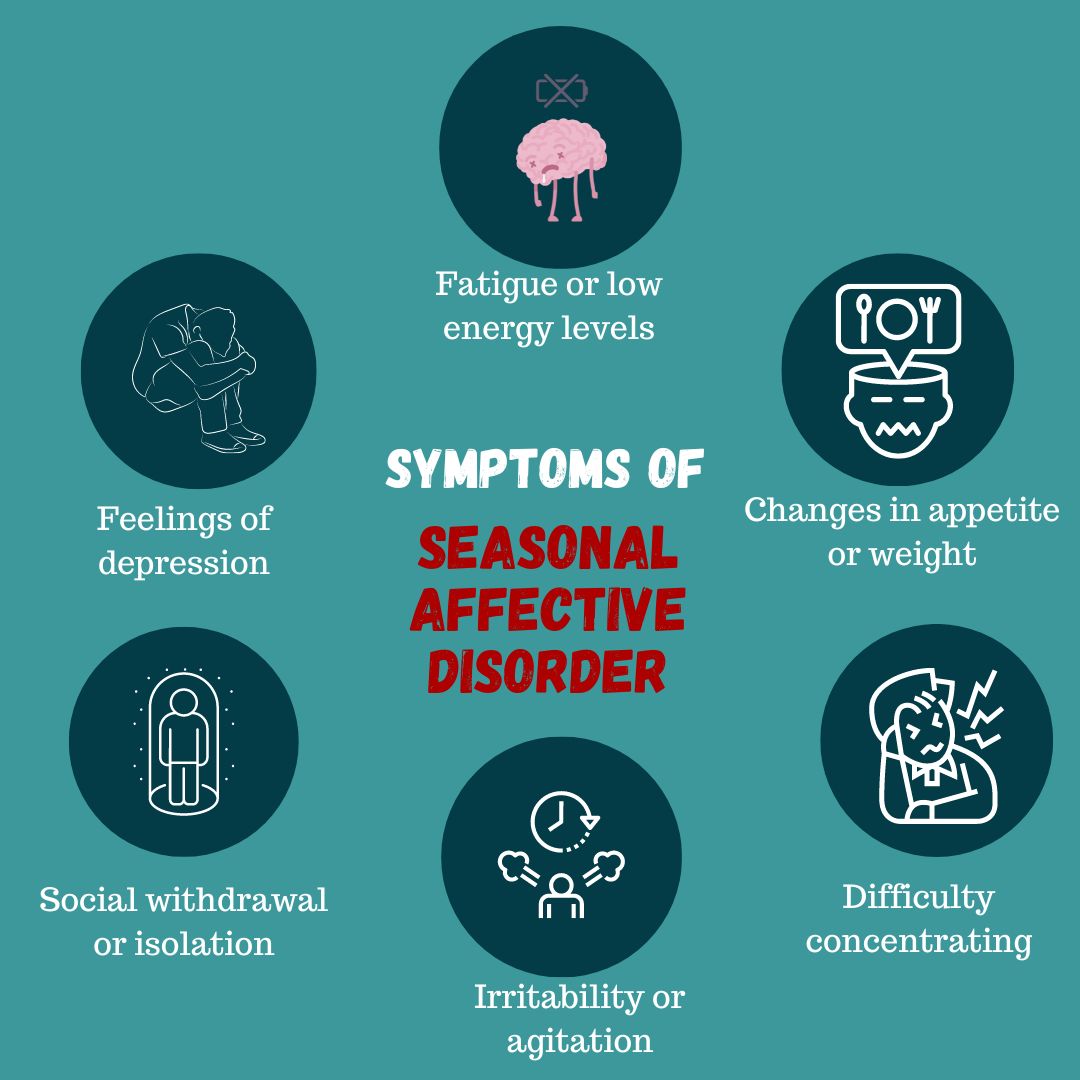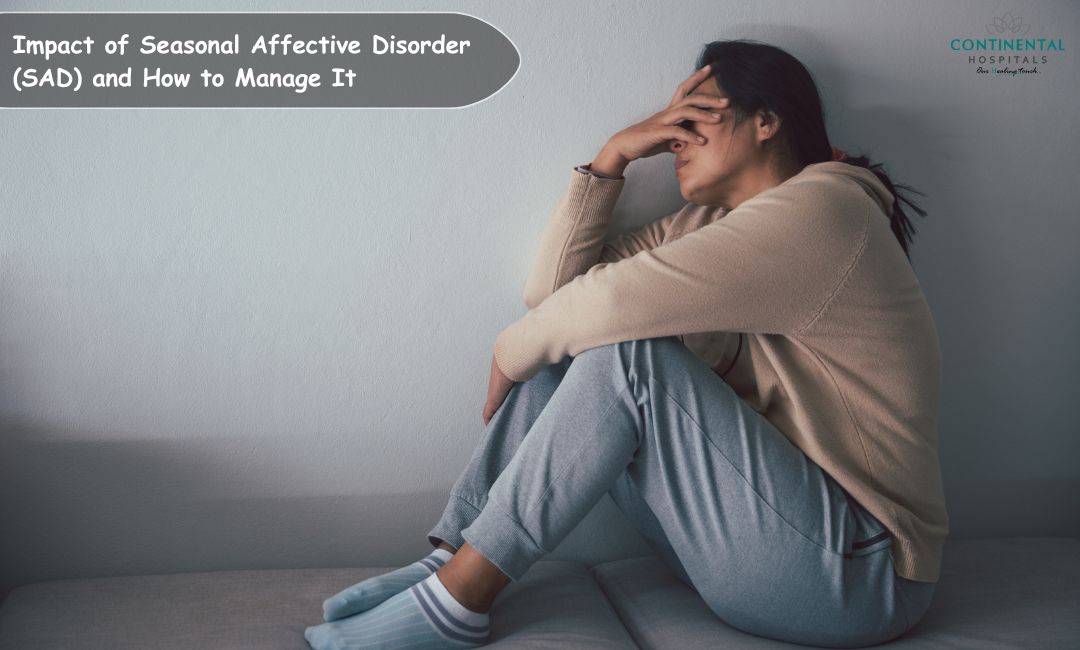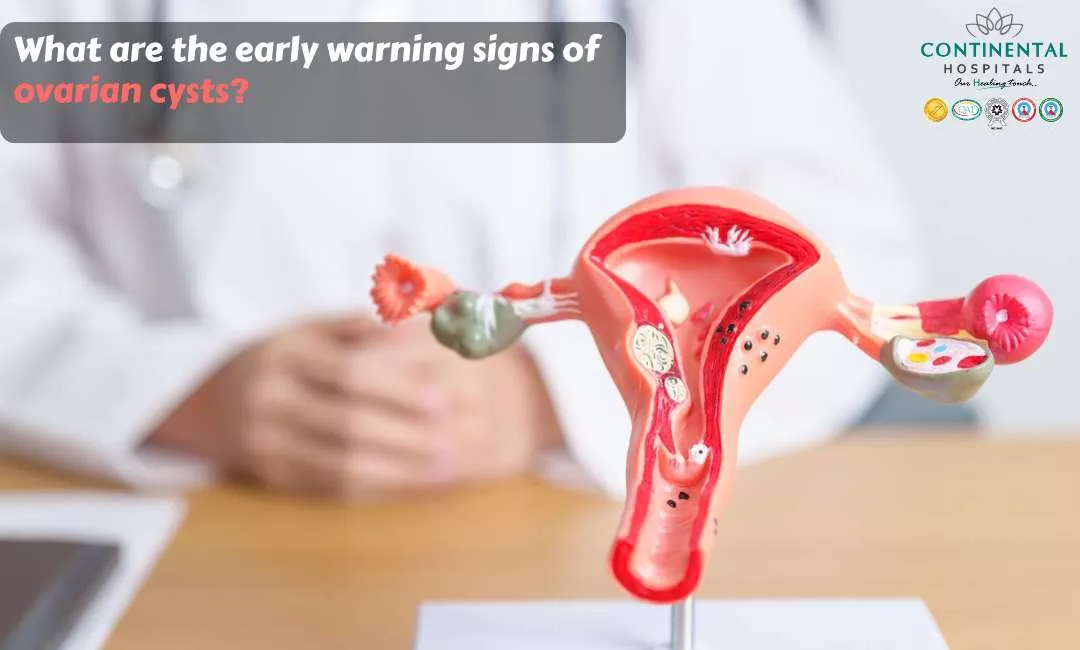Seasonal Affective Disorder (SAD) is a type of depression that occurs at specific times of the year, typically during fall and winter when daylight hours are shorter. While less common, some people also experience SAD during the spring or early summer months. The condition can significantly impact an individual's mood, energy levels, and overall well-being.
SAD is believed to be linked to reduced exposure to sunlight during certain seasons, which can disrupt the body's internal clock (circadian rhythm) and affect serotonin and melatonin levels—neurotransmitters that influence mood and sleep patterns.
Symptoms of SAD
Depressed mood: Feeling persistently sad, anxious, or empty.
Loss of interest or pleasure: Decreased interest in activities you once enjoyed.
Low energy: Feeling fatigued or having low energy levels, even with sufficient sleep.
Changes in sleep patterns: Sleeping too much or experiencing insomnia.
Changes in appetite or weight: Craving carbohydrates and gaining weight, or losing interest in food and losing weight.
Difficulty concentrating: Finding it hard to focus or experiencing brain fog.
Feeling hopeless or worthless: Negative thoughts about oneself or life in general.
Social withdrawal: Avoiding social interactions or feeling disconnected from others.
Irritability: Feeling agitated, easily annoyed, or experiencing mood swings.
Physical symptoms: Some individuals may experience physical symptoms like headaches or body aches.

If you or someone you know is experiencing these symptoms, it's essential to consult with a doctor or mental health professional.
Causes of SAD
Biological Factors: Changes in the body's internal clock (circadian rhythm) due to reduced sunlight can disrupt the balance of neurotransmitters like serotonin and melatonin, which play a role in regulating mood and sleep patterns.
Reduced Sunlight Exposure: Limited exposure to natural sunlight during the shorter days of winter can lead to imbalances in the body's production of serotonin and melatonin, contributing to symptoms of depression.
Genetics: Some individuals may be more predisposed to developing SAD due to a family history of the disorder or a genetic predisposition to depression.
Hormonal Changes: Variations in hormone levels, particularly serotonin and melatonin, triggered by changes in the seasons, can impact mood, sleep, and overall well-being.
Psychological Factors: People with a history of depression or other mood disorders might be more susceptible to developing SAD. Stress and other psychological factors can also exacerbate the symptoms.
Environmental Factors: Living far from the equator where daylight hours decrease significantly during the winter months can increase the risk of developing SAD.
Lifestyle Factors: Poor lifestyle habits such as inadequate nutrition, lack of exercise, or increased stress during the winter months can contribute to the onset or worsening of SAD symptoms.
Impact of SAD
Mood Changes: SAD can cause mood swings, feelings of sadness, hopelessness, irritability, and loss of interest in usual activities. People with SAD may also experience anxiety.
Fatigue and Sleep Issues: Individuals with SAD might feel more tired or experience changes in sleeping patterns, such as oversleeping or difficulty in falling asleep.
Weight Changes: Some individuals with SAD may experience changes in appetite, leading to weight gain due to increased cravings for carbohydrates and a lack of energy to exercise.
Difficulty Concentrating: SAD can impact cognitive functions, making it harder to focus, concentrate, and complete tasks.
Social Withdrawal: People with SAD may tend to withdraw from social activities, preferring isolation, which can further exacerbate feelings of depression.
Impact on Relationships: SAD can strain relationships due to changes in mood, reduced interest in activities, and social withdrawal.
Work or School Performance: The symptoms of SAD can affect performance at work or in school due to difficulties in concentration and decreased energy levels.
Risk Factors: Individuals with a family history of depression, living far from the equator where there are shorter daylight hours, and those with pre-existing mental health conditions are at higher risk of developing SAD.
Managing Seasonal Affective Disorder
Light Therapy: Light therapy involves exposure to a special light box that mimics natural sunlight. It's one of the primary treatments for SAD and can help alleviate symptoms by regulating the body's circadian rhythms. Sitting in front of a light box for about 20-30 minutes each morning can be beneficial.
Spend Time Outdoors: Maximize exposure to natural light by spending time outdoors during daylight hours. Even on cloudy days, natural light can still be beneficial.
Regular Exercise: Physical activity has been shown to improve mood and reduce symptoms of depression. Aim for regular exercise, such as walking, jogging, yoga, or any activity you enjoy.
Healthy Diet: A balanced diet rich in fruits, vegetables, whole grains, and lean proteins can positively impact mood and overall well-being.
Establish a Routine: Creating and sticking to a consistent daily routine can help regulate your internal body clock and improve symptoms of SAD.
Social Support: Stay connected with friends, family, or support groups. Social interactions can provide emotional support and help combat feelings of isolation.
Mindfulness and Relaxation Techniques: Practices like mindfulness meditation, deep breathing exercises, or yoga can reduce stress and improve mood.
Seek Professional Help: If symptoms of SAD persist or worsen, consider seeking help from a mental health professional. They can provide therapy, such as cognitive-behavioral therapy (CBT), or recommend medications if necessary.
Consider Supplements: Some people find relief from SAD symptoms by taking vitamin D supplements. However, it's essential to consult with a healthcare professional before starting any supplements.
Plan Enjoyable Activities: Engage in activities that bring you joy and fulfillment. Plan activities you enjoy or hobbies that you find relaxing or uplifting.
Seasonal Affective Disorder is a type of depression that affects many individuals during specific times of the year. However, with the right combination of strategies and support, it's possible to manage its symptoms effectively. Light therapy, spending time outdoors, regular exercise, a healthy diet, social support, counseling, and medication when necessary, are all valuable tools in combating SAD and improving overall well-being. If you or someone you know experiences symptoms of SAD, seeking professional help is essential for proper diagnosis and treatment.
If you or someone you know is experiencing these symptoms, it's essential to consult with a doctor or mental health professional.
Related Blog Articles-
1. Social Isolation in the Digital Age: Paradox or Reality?
2. Understanding Depression & Coping with It
3. Role of Meditation in Managing Depression
.webp)














